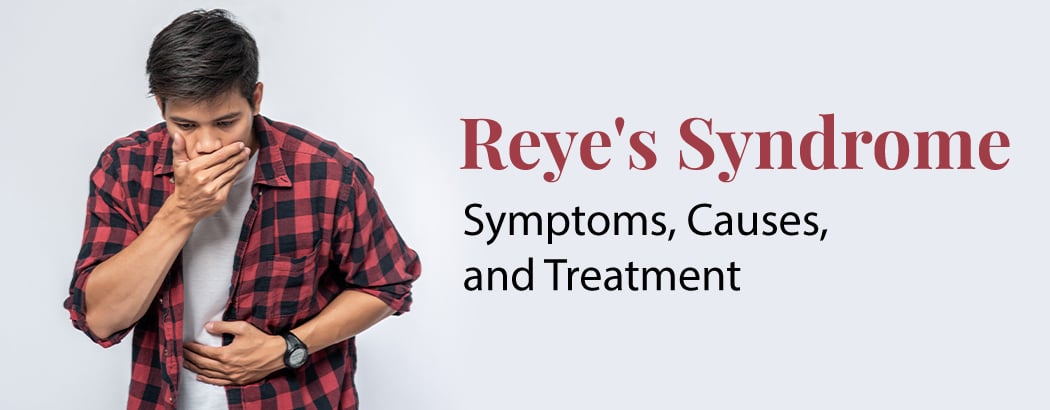Reye’s Syndrome: Symptoms, Causes, and Treatment
May 24, 2024

Overview
Reye’s syndrome is an uncommon but dangerous illness that involves swelling in the brain and liver. Although Reye’s syndrome can strike at any age, it typically strikes kids and teens following a viral infection—the flu or chickenpox.
Emergency care is required for symptoms including loss of consciousness, convulsions, and disorientation. Children with Reye’s syndrome can be saved if they receive therapy and diagnosis early on.
Contents
What is Reye’s Syndrome?
Reye’s syndrome is an uncommon condition that damages the liver and brain. Children with recent viral infections like the flu or chickenpox are more likely to develop Reye’s syndrome. Reye’s syndrome is substantially increased when aspirin is used to treat such an illness.
A headache is one of the most common symptoms of flu or chickenpox. Hence it’s vital to avoid giving aspirin to children for quick relief from headaches. The child might be in danger of getting Reye’s syndrome due to an undiagnosed viral infection.
Symptoms of Reye’s Syndrome
Reye’s syndrome symptoms often appear in the first few days following viral infection recovery. Reye’s Syndrome progresses in five stages, however, it has been established that newborns frequently do not predictably exhibit these symptoms.
Stage 1
- Frequent vomiting
- Sleepiness
- Fast breathing
- The symptoms of brain dysfunction
- Lethargy or lack of interest in activities
- Energy loss
- Headaches
Stage 2
- Agitation
- Further personality disorientations
- Violent conduct
- Profound sluggishness
- Drowsiness
- Confusion
- Hyperventilation
- Fatty liver (biopsy discovered)
- Reflexes that are too sensitive
Stage 3
- Persistence of symptoms from Stages I and II
- Uncertainty
- Delusions
- Illogical conduct
- Seizures
- Coma
- Rare events of pulmonary arrest
- Deflective posture
Stage 4
- Seizures
- Coma
- Dilated pupils with limited sensitivity to light
- Limited but persistent liver dysfunction
- Loss of oculocephalic reflexes
Stage 5
- Deep coma
- Areflexia
- Dilated, unresponsive pupils
- Multiple organ failure
- Seizures
- Respiratory arrest
- Hyperammonemia (more than 300 mg/dL of blood)
- Flaccidity
- Death
Causes of Reye’s Syndrome
As noted, there is no recognized treatment for Reye’s syndrome, and its precise etiology is unclear. On the other hand, children and young people recuperating from viral infections like the flu, chickenpox, or cold are typically affected by it. Over the winter, there is a higher-than-average number of cases of Reye’s syndrome. If the condition materializes, the liver experiences an abnormal fat accumulation while cerebral pressure increases. It can be deadly in a matter of days or even hours if left untreated. It is important that when a person is diagnosed with the condition, all other potential causes must be ruled out.
Since the discovery of Reye’s syndrome, research has revealed that certain hereditary metabolic abnormalities exhibit symptoms that are comparable to those of the condition. Aspirin should never be used to treat viral illnesses like chicken pox or flu as the chances of acquiring this syndrome.
Treatment of Reye’s Syndrome
Reye’s syndrome is a dangerous illness that can become critical, therefore getting treatment as soon as possible is crucial. The treatment procedure will generally be:
- Hospitalization is usually the course of treatment. Children will receive treatment in the intensive care unit in extreme circumstances. Since there isn’t a therapy for Reye’s syndrome, the goal of supportive care is to lessen symptoms and consequences.
- The doctors will closely monitor the child’s electrolyte balance and hydration.
- Doctors will assess the state of the heart and lungs (cardiorespiratory system).
- The liver function will be closely monitored.
- The right drugs will be administered to children with seizures to manage both the seizures and their negative effects.
- If the child’s breathing is excessively sluggish or inefficient, a breathing machine or respirator may be utilized in extreme circumstances.
The child’s prognosis improves with an earlier diagnosis of Reye’s syndrome. People who develop the disease to its later stages run the risk of suffering irreversible brain damage.
Conclusion
If there are behavioral changes in a child or new symptoms following a viral infection or sickness, it might be beneficial to recognize the warning signs of Reye’s syndrome and get the child seen by a healthcare professional as soon as possible. To protect the child from viral diseases, particularly in the fall and winter, vaccines should be given on time. If the kid is diagnosed with Reye’s syndrome, the healthcare team will provide parents with updates on their health and assistance.
Although Reye’s syndrome is incredibly rare, when it does occur, it can be devastating. It is important to differentiate this ailment from other conditions that may present with comparable symptoms. To prevent long-term health harm or worse, early diagnosis is crucial.
Frequently Asked Questions
1. Is there a cure for Reye’s syndrome?
There’s no cure for Reye’s syndrome. Depending on their diagnosis, many children make a full recovery. Treatment reduces symptoms and aims to prevent long-term complications or death.
2. When should I visit a physician?
Consult your healthcare professional right away if your kid takes aspirin (salicylate) without authorization or exhibits any symptoms of Reye’s syndrome mentioned above following a viral sickness or infection.
3. How can I prevent my child from acquiring Reye’s syndrome?
Reye’s syndrome can be avoided by not providing aspirin to children, especially if they are under 16 years old, as there is a connection between the two conditions. Instead, talk to your healthcare professional about the planned course of treatment.
4. Who is affected by Reye’s syndrome?
Reye’s syndrome can strike anybody at any age, however it predominantly affects youngsters. Cases mostly involve youngsters under the age of eighteen and generally occur in the fall and winter.







